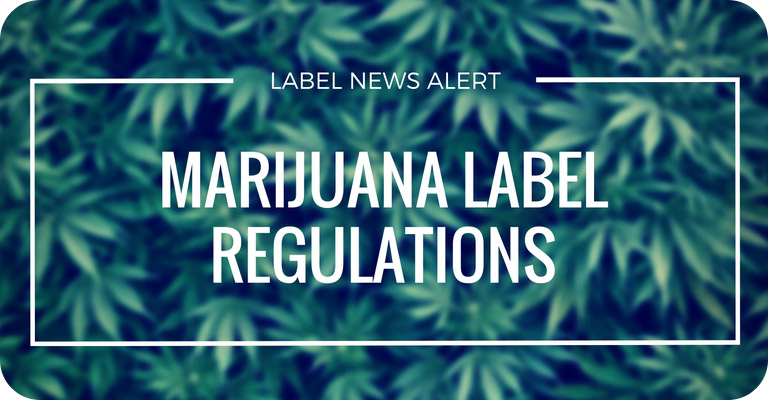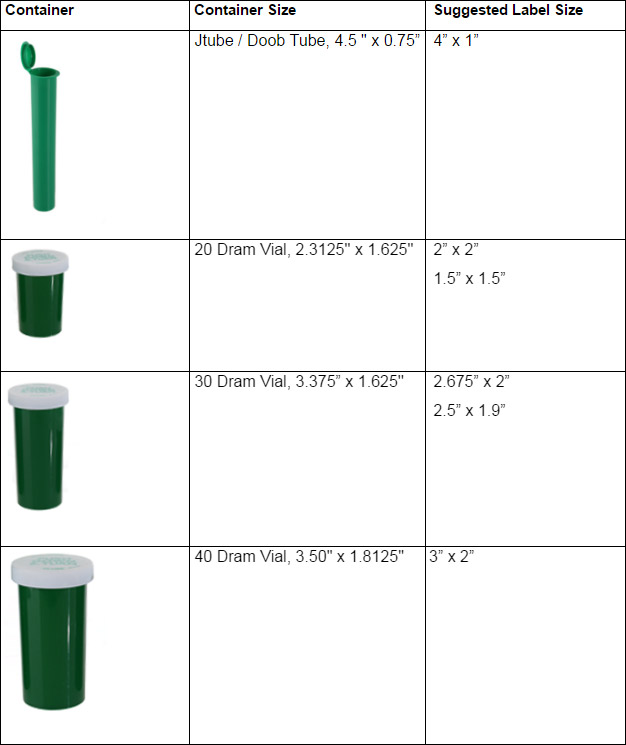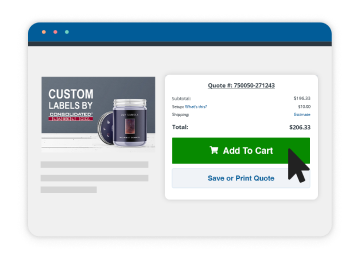
Marijuana use may be polarizing the nation, but as an industry, it’s bringing in billions. By 2020, medical marijuana will bring in more than $10 billion in sales and be worth roughly $30 billion, according to ArcView Market Research and Bank of America Merrill Lynch. To keep up with this growing trend and legal battle, here’s what you need to know in order to adhere to regulations and guidelines when creating marijuana packaging labels.
Marijuana is said to help with symptoms of many diseases and ailments, including Parkinson’s disease, Crohn’s disease, Tourette’s syndrome, Alzheimer’s, lupus, and rheumatoid arthritis. In the recent election, four states approved legalized recreational marijuana (California, Maine, Massachusetts, and Nevada) and three states passed medical marijuana (Arkansas, Florida, and North Dakota). Marijuana is still prohibited on a federal level, however, that may change sooner than later considering half the country – 28 states – have made marijuana legal in some form.
If you’re a licensed marijuana dispensary, stay up to date with these facts about the drug and the rules for compliant marijuana packaging.
Marijuana by the Numbers
- The number of marijuana legalization ballots this Election Day will be the largest number of voters weighing in on the issue.
- More than 145 million people around the world use marijuana, equivalent to 2.5% of the planet’s population.
- Each hemp plant could supply as much value as 12 trees in terms of biodiesel, paper products, and concrete.
- Today’s weed is 57-67% more potent than what we were capable of growing in the 60s and 70s.
- State and federal governments spend more than $17 billion on marijuana prohibition efforts.
- Gallup found that 53% of the US population favors legalizing marijuana use (as of 2015), up from just 12% in 1969.
How Dispensaries Must Label Their Products
Unfortunately, the lack of national legislation has made outlining the parameters of selling marijuana difficult. Each state is free to determine their own rules and regulations with regards to the required labels and warnings. Not only are these rules constantly changing, they’re also enforced and interpreted differently.
Below is a list of warnings that at least one state requires on their commercial marijuana. There are variations in phrasing that are not listed. For a more detailed listing and a breakdown by state, visit Leafly’s State-by-State Guide.
Warnings:
- Habit Forming: Marijuana has intoxicating effects and may be habit forming and addictive.
- Impaired Abilities: Marijuana can impair concentration, coordination, and judgment. Do not operate a vehicle or machinery under the influence of this drug. Please use extreme caution.
- Health Risks: There is limited information on the side effects of using this product, and there may be associated health risks. Marijuana should not be used by women who are pregnant or breastfeeding.
- Age: For use only by adults twenty-one and older. Keep out of the reach of children and animals.
- Resale/Transfer: This product is for medical use only, not for resale or transfer to another person. It is a illegal for any person to possess or consume the contents of the package other than the qualifying patient.
- Medical Use Only: This medical cannabis is for therapeutic use only. It is not intended to diagnose, treat, cure, or prevent any disease.
- Miscellaneous:
- Schedule I controlled substance.
- For medical use only.
- The intoxicating effects of this product may be delayed by up to two hours.
- [Poison Control Center emergency telephone number.]
- This product has not been analyzed or approved by the FDA.
- Keep secured at all times.
- This product may be unlawful outside of [state of origin].
Retailer/Manufacturer Identification:
- Identity of the marijuana retail store and marijuana establishment license number from the Department of Food and Agriculture.
- A pass or fail rating based on the laboratory’s microbiological, mycotoxins, heavy metals, pesticide, solvent residue and chemical residue analysis.
- The name and P.O. Box of the registered cultivation center where the item was manufactured.
- The name of licensee that packaged the medical cannabis finished. product and the telephone number of the licensee for reporting an adverse patient event.
- The dispensary’s telephone number and mailing address, and website information, if any.
Dates:
- Date and source of cultivation.
- The date of final testing and packaging.
- The expiration date.
- The dispensing date that the medical marijuana was transferred to the qualified patient or caregiver.
- The date of harvest.
- A “use by” or “freeze by” date for products capable of supporting the growth of infectious, toxigenic, or spoilage microorganisms.
Ingredients:
- A terpenes profile and a list of pharmacologically active ingredients, including, but not limited to, tetrahydrocannabinol (THC), tetrahydrocannabinol acid (THCA), cannabidiol (CBD), cannabidiolic acid (CBDA), and other cannabinoid content, and colors, artificial flavors, and preservatives, with the amount in milligrams per serving and servings per package.
- A warning if nuts or other known allergens are used.
- All ingredients in edible marijuana products. Only generic food names may be used to describe these ingredients.
Weight: The quantity (in ounces or grams) of cannabis contained in the product.
Product Information:
- A unique serial number or other identifier that will match the product with a producer batch and lot number so as to facilitate any warnings or recalls the department or producer deem appropriate.
- The name of the strain, batch, and quantity.
- The medical marijuana is free of contaminants.
- Whether the medical marijuana is of the low, medium, or high strength strain.
- An unaltered universal symbol identified by the state shall be visible on the product packaging.
Recipient Information:
- The name of the recommending physician.
- The qualifying patient’s name, address, and registration card number.
- The patient’s date of birth.
- The name and date of birth of the designated registered caregiver, if applicable.
Additional Information:
- Any directions for use of the product.
- The instructions for proper storage or handling of the product.
- The medical marijuana product form and brand designation.
- If a marijuana extract was added to the product, disclosure of the type of extraction process and any solvent, gas, or other chemical used in the extraction process, or any other compound added to the extract.
Other considerations during the marijuana labeling process are the restrictions on design. The following rules are instituted in at least one state. Consult Leafly’s guide for state-specific regulations.
- The packaging may not be designed to appeal to children.
- Products shall be labeled and placed in a resealable, tamper-evident, and child-resistant package.
- All edible cannabis products are required to be in opaque packaging.
- Labeling text must be no smaller than 1/16 of an inch.
- Labeling text must be clearly written or printed and in the English language.
- Labeling text must be unobstructed and conspicuous.
- Bear no resemblance to the trademarked, characteristic, or product-specialized packaging of any commercially available candy, snack, baked good or beverage.
- Bear no statement, artwork, or design that could reasonably mislead any person to believe that the package contains anything other a medical cannabis finished product.
- Bear no seal, flag, crest, coat of arms, or other insignias that could reasonably mislead any person to believe that the product has been endorsed, manufactured, or used by any state, county, or municipality, or any agency thereof.
Custom Labels for Marijuana Products
Our materials are tested by our suppliers to ensure quality and performance standards are met. Paper labels are our most popular material option because it’s cost-effective and works with a variety of products and markets. For marijuana products, however, we recommend film labels since they’re generally more durable and last longer than paper labels, ensuring vital product information doesn’t get ruined by moisture, friction, handling, etc. We can also print your custom labels in a variety of styles like glossy, matte, foil, and holographic-patterned to make your product and brand stand out.
Along with materials, we also offer a variety of label sizes and shapes. Listed below are examples of popular medical marijuana container sizes and suggested label sizes.

Disclaimer
This article is meant to be used as a labeling guide, not as an authoritative resource on the latest marijuana legislation. At the time of publication (August 2016), the information mentioned above is compliant with state and federal laws. Please be sure to check government databases for updates or revisions as regulations can change frequently. We are not responsible or liable for any actions taken as a result of using the content or resources listed above.
Sources
International Business Times
Money Morning
Leafly
ProCon.org
Herb.Co
Huffington Post
PEW Research
A version of this article was originally published on our sister company’s website OnlineLabels.com.


